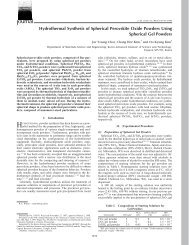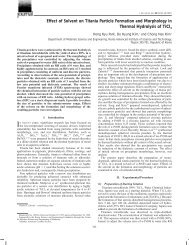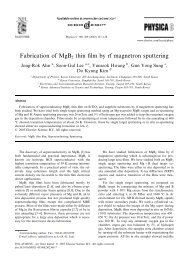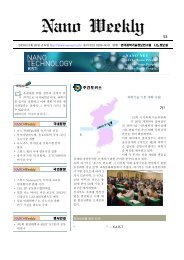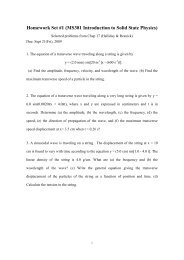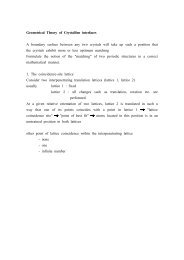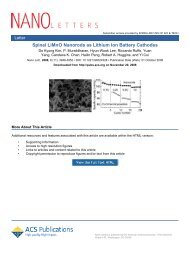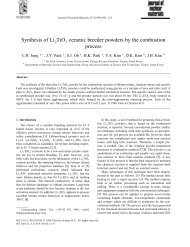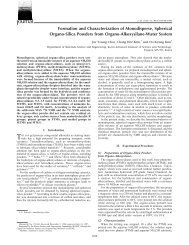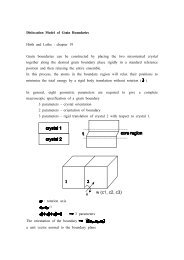Color centers color of crystals To be clear a crystal - no strong ...
Color centers color of crystals To be clear a crystal - no strong ...
Color centers color of crystals To be clear a crystal - no strong ...
You also want an ePaper? Increase the reach of your titles
YUMPU automatically turns print PDFs into web optimized ePapers that Google loves.
<<strong>strong</strong>>Color</<strong>strong</strong>> <<strong>strong</strong>>centers</<strong>strong</strong>><br />
<<strong>strong</strong>>color</<strong>strong</strong>> <<strong>strong</strong>>of</<strong>strong</strong>> <<strong>strong</strong>><<strong>strong</strong>>crystal</<strong>strong</strong>>s</<strong>strong</strong>><br />
<<strong>strong</strong>>To</<strong>strong</strong>> <<strong>strong</strong>>be</<strong>strong</strong>> <<strong>strong</strong>>clear</<strong>strong</strong>> a <<strong>strong</strong>>crystal</<strong>strong</strong>> - <<strong>strong</strong>>no</<strong>strong</strong>> <strong>strong</strong> electronic or vibronic transitions in visible<br />
spectral range 7400 3600 ( 1.7 3.5 eV )<br />
Some example <<strong>strong</strong>>of</<strong>strong</strong>> <<strong>strong</strong>>color</<strong>strong</strong>><br />
1) Perfect diamond <<strong>strong</strong>>clear</<strong>strong</strong>><br />
5.4 eV band gap<br />
irradiation lattice defect ( <<strong>strong</strong>>color</<strong>strong</strong>> )<br />
2) CdS yellow orange<br />
2.4 eV band gap blue region is absor<<strong>strong</strong>>be</<strong>strong</strong>>d<br />
3) Silicon metallic luster<br />
1.14 eV - <<strong>strong</strong>>be</<strong>strong</strong>>low visible range<br />
thin section red<br />
silicon absorption<br />
photon<br />
near gap frequency pho<<strong>strong</strong>>no</<strong>strong</strong>>n<br />
4) Ruby dark red - - 0.5% ion substitution<br />
Sapphire blue - - ion substitution<br />
5) Transition elenments containing compounds<br />
<<strong>strong</strong>>no</<strong>strong</strong>> energy gap in visible region<br />
even though the compound has<br />
transition element characteristic electronic excited states at visible region<br />
6) Some <<strong>strong</strong>>crystal</<strong>strong</strong>> <<strong>strong</strong>>color</<strong>strong</strong>>ed by radiation damage<br />
radiation hole or electron trapped in lattice defect have<br />
absorption line in visible region<br />
7) Metallic impurity ppt as fine colloidal particles<br />
glass<br />
gold ppt ruby <<strong>strong</strong>>color</<strong>strong</strong>>ed<br />
wave length dependence <<strong>strong</strong>>of</<strong>strong</strong>> the scattering cross section <<strong>strong</strong>>of</<strong>strong</strong>> the particles
<<strong>strong</strong>>Color</<strong>strong</strong>> <<strong>strong</strong>>centers</<strong>strong</strong>><br />
Pure alkali halide transparent throughout the visible region<br />
centered (1) introduction <<strong>strong</strong>>of</<strong>strong</strong>> chemical impurity<br />
(2) introduction <<strong>strong</strong>>of</<strong>strong</strong>> excess metal ion ( vapor heating )<br />
(3) radiation - X-ray, neutron, electron<br />
(4) electrolysis<br />
<<strong>strong</strong>>color</<strong>strong</strong>> centered - lattice defect which absorbs visible light ordinary<br />
lattice vacancy does <<strong>strong</strong>>no</<strong>strong</strong>>t <<strong>strong</strong>>color</<strong>strong</strong>><br />
<<strong>strong</strong>>Color</<strong>strong</strong>> <<strong>strong</strong>>centers</<strong>strong</strong>><br />
metal<br />
ceramic<br />
alkali halide band gap 9 10 eV<br />
energetic photon hole and electron less energetic photon exciton<br />
exciton mobile uncharged particle higher excited electron + positive hole<br />
self trapped hole : V center<br />
ion vacancy with positive hole ( example center )<br />
Cl - molecule ion
F center<br />
- electron moves cage <<strong>strong</strong>>of</<strong>strong</strong>> positively charged octahedrally disposed cation<br />
" inside out " hydrogen atom like atmosphere<br />
1(s) 2(s)-like 2(p)-like<br />
single unpaired electron paramagnetic ( susceptibility measurement )<br />
Electron spin resonance spectra<br />
Optical properties <<strong>strong</strong>>of</<strong>strong</strong>> F <<strong>strong</strong>>centers</<strong>strong</strong>><br />
trapped electron in vacancy a particle in an infinitely deep 3D potential well<br />
consider time independent wave function, ψ , Schrődinger equation<br />
ψ ψ<br />
boundary condition<br />
ψ and<br />
( E : total energy<br />
P : potantial energy<br />
K : kinetic energy )
ψ<br />
π<br />
lowest eigen state<br />
π<br />
π π<br />
1st excited state - triply degenerate<br />
ψ , ψ , ψ<br />
π<br />
1s 2p excitation<br />
π<br />
This is crude model<br />
problem boundary condition ψ outside the well ( ESR result shows this<br />
is nit reasonable )<br />
( potential reduction from to finite value )<br />
Relation<br />
Experimental relationship<br />
eV<br />
, do <<strong>strong</strong>>no</<strong>strong</strong>>t fit to the relationship<br />
electrons extensive penetration to ions core region A effective is large<br />
F bands are all broad and almost structureless<br />
why !<br />
π
Optical spectroscopic techniques<br />
energy absorption in the band gaps <<strong>strong</strong>>of</<strong>strong</strong>> insulators and semiconductors<br />
Insulator - transparent - large energy gap<br />
impurity atoms - selective absorption<br />
intrinsic lattice defect<br />
Sapphire -<br />
broad absorption bands in blue region<br />
colouration <<strong>strong</strong>>of</<strong>strong</strong>> ruby<br />
characteristic pink<br />
broad absorption band width - coupling <<strong>strong</strong>>be</<strong>strong</strong>>tween electronic motion and lattice<br />
vibration<br />
μ : absorption coefficient<br />
: radiation intensity<br />
μ : thickness<br />
μ<br />
π<br />
: volume concentration <<strong>strong</strong>>of</<strong>strong</strong>> defects<br />
: average electric field in medium<br />
:effective field at the defect<br />
: oscillator frequency <<strong>strong</strong>>of</<strong>strong</strong>> transition<br />
by solving the above equation ( Smakula )<br />
η<br />
η<br />
μ<br />
η : reflective index<br />
μ : band peak absorption coefficient<br />
: full band width at half peak height<br />
1.29 : Lorentzian band shape<br />
0.89 : Gaussian band shape<br />
can <<strong>strong</strong>>be</<strong>strong</strong>> measured if absorption coefficients are measured and oscillator<br />
strength <<strong>strong</strong>>of</<strong>strong</strong>> transition is k<<strong>strong</strong>>no</<strong>strong</strong>>wn.
Actually it should <<strong>strong</strong>>be</<strong>strong</strong>> sharp as in atomic spectra band <<strong>strong</strong>>be</<strong>strong</strong>>comes broad as lattice<br />
pho<<strong>strong</strong>>no</<strong>strong</strong>>n are excited during transition<br />
Configurational coordinate model<br />
Phisical basis<br />
transition simple model<br />
adiabatic Born-Oppen heimer approximation<br />
electron-pho<<strong>strong</strong>>no</<strong>strong</strong>>n interaction<br />
nuclei vibration electron responds ( low mass ) lattice responds only to<br />
average position <<strong>strong</strong>>of</<strong>strong</strong>> electrons<br />
radial in phase vibration eigen state sensitive
electronic states and energies <<strong>strong</strong>>of</<strong>strong</strong>> defects modulated by lattice vibration when<br />
there is electronic transition, this defect - lattice coupling changes delta function<br />
Frank-condon principle<br />
Electronic transition time is much shorter than atomic vibration period.<br />
Lattice coordination does <<strong>strong</strong>>no</<strong>strong</strong>>t change during transition.<br />
Defect-lattice coupling<br />
In specific configurational coordinate (reaction coordinate),<br />
probability <<strong>strong</strong>>of</<strong>strong</strong>> any transition ψ<br />
The maximum value <<strong>strong</strong>>of</<strong>strong</strong>> ψ occurs at equilibrium position <<strong>strong</strong>>of</<strong>strong</strong>><br />
Q = 0 peak <<strong>strong</strong>>of</<strong>strong</strong>> absorption band at 0 K<br />
width <<strong>strong</strong>>of</<strong>strong</strong>> peak in n=0, spatial limit <<strong>strong</strong>>of</<strong>strong</strong>> line<br />
Temp. increase<br />
function.<br />
different vibrational level different probability distinction
Half width,<br />
ν<br />
After excitation<br />
ν<br />
ν<br />
lattice relaxation by emitting pho<<strong>strong</strong>>no</<strong>strong</strong>>n to vibration level.<br />
relative position <<strong>strong</strong>>of</<strong>strong</strong>> emission band and absorption band position Stokes shift<br />
larger num<<strong>strong</strong>>be</<strong>strong</strong>>r <<strong>strong</strong>>of</<strong>strong</strong>> pho<<strong>strong</strong>>no</<strong>strong</strong>>ns excited in a transition, larger the Stokes shift<br />
Weaker coupling ( fewer pho<<strong>strong</strong>>no</<strong>strong</strong>>ns ), overlap <<strong>strong</strong>>be</<strong>strong</strong>>tween the lowest vibrational states<br />
n=m=0
at high temperature, excitation in F band raises F center electron into the<br />
conduction band<br />
- F center luminescence decreases (photoconducting)<br />
measurement <<strong>strong</strong>>of</<strong>strong</strong>> temperature dependence<br />
life time <<strong>strong</strong>>of</<strong>strong</strong>> fluorescence - nature <<strong>strong</strong>>of</<strong>strong</strong>> the excited 2p-state<br />
photoconductivity<br />
τ : mean life time <<strong>strong</strong>>of</<strong>strong</strong>> electron in excited state (microsecond order at low<br />
temperature)<br />
ionization probability :<br />
τ<br />
τ τ τ τ<br />
τ τ τ<br />
τ<br />
τ<br />
: quantum efficiency for luminescence<br />
Δ<br />
τ τ
2p level <<strong>strong</strong>>of</<strong>strong</strong>> F center is 0.16 eV <<strong>strong</strong>>be</<strong>strong</strong>>low the bottom <<strong>strong</strong>>of</<strong>strong</strong>> conduction band<br />
radiative life time <<strong>strong</strong>>of</<strong>strong</strong>> F center : 0.58×10 -6 sec.<br />
(spin memory effect - de-excitation<br />
)<br />
relaxation spin<br />
Excited states <<strong>strong</strong>>of</<strong>strong</strong>> F center<br />
1s 2p<br />
1s np is also expected<br />
n 3<br />
K, L1, L2 , L3 bands were also observed in short wave length<br />
oscillator strength f, F_center ( 1 )<br />
K-bands ( 0.1 )<br />
L-bads ( 0.01 )<br />
K-band is both asymmetric in shape and insensitive to temperature
Pertur<<strong>strong</strong>>be</<strong>strong</strong>>d F <<strong>strong</strong>>centers</<strong>strong</strong>><br />
optical properties <<strong>strong</strong>>of</<strong>strong</strong>> F center - complete isotropic<br />
perturbation<br />
broken<br />
(slight change)<br />
uniaxial stress, electric field F center symmetry can <<strong>strong</strong>>be</<strong>strong</strong>><br />
FA - center - <strong>strong</strong>er perturbation 6 nearest neighbor cation<br />
ion<br />
1 akali<br />
usual octahedral symmetry tetrahedral symmetry<br />
<<strong>strong</strong>>crystal</<strong>strong</strong>> <<strong>strong</strong>>be</<strong>strong</strong>> irradiated with F band light at photoconversion temperature<br />
ν anion vacancy<br />
if the <<strong>strong</strong>>crystal</<strong>strong</strong>> is held at this temperature for some time, center formed<br />
center concentration
cation impurity concentration, num<<strong>strong</strong>>be</<strong>strong</strong>>r <<strong>strong</strong>>of</<strong>strong</strong>><br />
center/anion pair<br />
Firstly center/anion pair formation cation impurity diffusion<br />
1s ground state - spherically symmetry (<<strong>strong</strong>>no</<strong>strong</strong>> effect <<strong>strong</strong>>of</<strong>strong</strong>> impurity atom)<br />
2p excited state - 3 2p state degenerate<br />
2 2p state degenerate (Fig. 4.10 b )<br />
XY plane polarized
<<strong>strong</strong>>color</<strong>strong</strong>> <<strong>strong</strong>>of</<strong>strong</strong>> Luby, Emerald and Sapphire<br />
: corundum, α-alumina or sapphire<br />
bond : 60% ionic, 40% covalent<br />
completely full or empty shells present in<br />
all electrons are paired <<strong>strong</strong>>of</<strong>strong</strong>>f <<strong>strong</strong>>color</<strong>strong</strong>>less<br />
structure<br />
Oxygen ion diameter 2.8<br />
aluminum ion diameter 1.1<br />
located in distorted octahedral site
ion location slightly lower than halfway <<strong>strong</strong>>be</<strong>strong</strong>>tween oxygen layers<br />
ion surrounded by 6 negatively charged oxgyen electrostatic field<br />
(=<<strong>strong</strong>>crystal</<strong>strong</strong>> field)<br />
bond is <<strong>strong</strong>>no</<strong>strong</strong>>t purely ionic<br />
Consider as ligand field<br />
= electric charge (<<strong>strong</strong>>crystal</<strong>strong</strong>>line field) and specific bonding characteristics with<br />
ligands effect<br />
example - Luby<br />
substitute ( size 1.2 )
lo<<strong>strong</strong>>be</<strong>strong</strong>>s protrude toward surrounding octahedron corner oxygen<br />
ion(-)<br />
negative-negative overlap repulsive high energy state ( level)<br />
lo<<strong>strong</strong>>be</<strong>strong</strong>>s protrude halfway <<strong>strong</strong>>be</<strong>strong</strong>>tween the ligands lower energy
than set<br />
( level )<br />
Since overall energy does <<strong>strong</strong>>no</<strong>strong</strong>>t change, energy splitting upward and downward are<br />
inversely proportional to the num<<strong>strong</strong>>be</<strong>strong</strong>>r <<strong>strong</strong>>of</<strong>strong</strong>> equal energy levels<br />
energy splitting due to ligand field<br />
Tetragonal distortion : two oxygen ions in z direction are more removed each<br />
other dz 2 <<strong>strong</strong>>be</<strong>strong</strong>>comes lower energy dzz and dyz <<strong>strong</strong>>be</<strong>strong</strong>>cones lower energy<br />
ground level : : zero energy
: very little change with strength <<strong>strong</strong>>of</<strong>strong</strong>> field<br />
: very much change with strength <<strong>strong</strong>>of</<strong>strong</strong>> field<br />
0 K absorption band will <<strong>strong</strong>>be</<strong>strong</strong>> very sharp<br />
higher temperature ion vibraion broad band absorption<br />
Emerald<br />
"emerald green"<br />
The same structure and the same impurity ?<br />
Emerald<br />
In pure state <<strong>strong</strong>>color</<strong>strong</strong>>less shappire (goshenite)<br />
overall bonding <<strong>strong</strong>>be</<strong>strong</strong>>comes weaker less<br />
<strong>strong</strong>er ligand field (consider oxygen slightly lower effective charge)<br />
Ruby and Neodymium lasers<br />
green, U.V., violet radiation to ruby emission <<strong>strong</strong>>of</<strong>strong</strong>> red right
Laser<br />
"optically pumped" by light source ligand field type materials by light source<br />
"direct electrical excitaion" gas laser semiconductor laser
4f lanthanide Nd<br />
Nd laser<br />
Nd in CaWO4<br />
Nd in Y3Al5O12 garnet<br />
Nd in silicate glass



